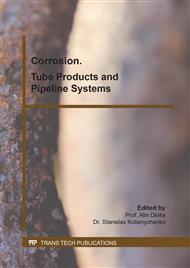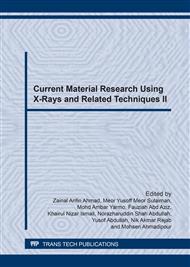[1]
D. Kuang, Y.F. Cheng, Study of cathodic protection shielding under coating disbondment on pipelines, Corros. Sci. 99 (2015) 249-257.
DOI: 10.1016/j.corsci.2015.07.012
Google Scholar
[2]
C. Wen, J. Li, S. Wang, Y. Yang, Experimental study on stray current corrosion of coated pipeline steel, J. Nat. Gas Sci. Eng. 27 (2015) 1555-1561.
DOI: 10.1016/j.jngse.2015.10.022
Google Scholar
[3]
E.O. Obanijesu, R. Gubner, A. Barifcani, V. Pareek, M.O. Tade, The influence of corrosion inhibitors on hydrate formation temperature along the subsea natural gas pipelines, J. Petrol. Sci. Eng. 120(1) (2014) 239-252.
DOI: 10.1016/j.petrol.2014.05.025
Google Scholar
[4]
L. Yohai, M.B. Valcarce, M. Vázquez, Testing phosphate ions as corrosion inhibitors for construction steel in mortars, Electrochim. Acta. 202 (2016) 316-324.
DOI: 10.1016/j.electacta.2015.12.124
Google Scholar
[5]
F. l. Fei, J. Hu, J. X. Wei, Q.J. Yu, Z. -s. Chen, Corrosion performance of steel reinforcement in simulated concrete pore solutions in the presence of imidazoline quaternary ammonium salt corrosion inhibitor, Constr. Build. Mater. 70(1) (2014).
DOI: 10.1016/j.conbuildmat.2014.07.082
Google Scholar
[6]
Y. M. Han, D. Gallant, X.G. Chen, Corrosion inhibition of Al-B4C metal matrix composites in a NaCl solution by benzotriazole, Mater. Chem. Phys. 139(1) (2013) 187-195.
DOI: 10.1016/j.matchemphys.2013.01.021
Google Scholar
[7]
C.P. Gerba, Quaternary ammonium biocides: Efficacy in application, Appl. Environ. Microb. 81(2) (2015) 464-469.
DOI: 10.1128/aem.02633-14
Google Scholar
[8]
K.V. Rybalka, L.A. Beketaeva, A.D. Davydov, Estimation of corrosion current by the analysis of polarization curves: Electrochemical kinetics mode, Russ. J. Electrochem. 50(2) (2014) 108-113.
DOI: 10.1134/s1023193514020025
Google Scholar
[9]
N. Mohamad, A. Jalar, N.K. Othman, Surface morphology study on aluminum alloy after treated with silicate-based corrosion inhibitor from paddy residue, Sains Malays. 43(6) (2014) 935-940.
Google Scholar
[10]
S.A. Umoren, I.B. Obot, E.E. Ebenso, N.O. Obi-Egbedi, The Inhibition of aluminium corrosion in hydrochloric acid solution by exudate gum from Raphia hookeri, Desalination. 247(1-3) (2009) 561-572.
DOI: 10.1016/j.desal.2008.09.005
Google Scholar
[11]
E. Bayol, T. Gürten, A.A. Gürten, M. Erbil, Interactions of some Schiff base compounds with mild steel surface in hydrochloric acid solution, Mater. Chem. Phys. 112(2) (2008) 624-630.
DOI: 10.1016/j.matchemphys.2008.06.012
Google Scholar
[12]
M.N. Idris, A.R. Daud, N.K. Othman, A. Jalar, Corrosion control by benzyl triethylammonium chloride: Effects of temperature and its concentration, Inter. J. Eng. Tech. 13(3) (2013) 47-51.
Google Scholar
[13]
M. Sahin, S. Bilgic, H. Yilmaz, The inhibition effects of some cyclic nitrogen compounds on the corrosion of the steel in NaCl medium, Appl. Surf. Sci. 195(14) (2002) 1-7.
Google Scholar
[14]
D. Seifzadeh, H. Basharnavaz, A. Bezaatpour, A Schiff base compound as effective corrosion inhibitor for magnesium in acidic media, Mater. Chem. Phys. 138(23) (2013) 794-802.
DOI: 10.1016/j.matchemphys.2012.12.063
Google Scholar
[15]
J.F. Moulder, W.F. Stickle, P.E. Sobol, K.D. Bomben, Handbook of X-ray photoelectron spectroscopy, Perkin Elmer Corporation, Minnesota, United State of America, (1992).
Google Scholar
[16]
H. Zhang, D. Wang, F. Wang, X. Jin, T. Yang, Z. Cai, J. Zhang, Corrosion inhibition of mild steel in hydrochloric acid solution by quaternary ammonium salt derivatives of corn stalk polysaccharide (QAPS), Desalination. 372 (2015) 57-66.
DOI: 10.1016/j.desal.2015.06.021
Google Scholar
[17]
K. Bílková, E. Gulbrandsen, Kinetic and mechanistic study of CO2 corrosion inhibition by cetyl trimethyl ammonium bromide, Electrochim. Acta. 53(16) (2008) 5423-5433.
DOI: 10.1016/j.electacta.2008.02.096
Google Scholar
[18]
F. Bentiss, C. Jama, B. Mernari, H.E. Attari, L.E. Kadi, M. Lebrini, M. Traisnel, M. Lagrenée, Corrosion control of mild steel using 3, 5-bis(4-methoxyphenyl)-4-amino-1, 2, 4-triazole in normal hydrochloric acid medium, Corros. Sci. 51(8) (2009).
DOI: 10.1016/j.corsci.2009.04.009
Google Scholar
[19]
M. Tourabi, K. Nohair, M. Traisnel, C. Jama, F. Bentiss, Electrochemical and XPS studies of the corrosion inhibition of carbon steel in hydrochloric acid pickling solutions by 3, 5-bis(2-thienylmethyl)-4-amino-1, 2, 4-triazole, Corros. Sci. 75(1) (2013).
DOI: 10.1016/j.corsci.2013.05.023
Google Scholar
[20]
H. Zarrok, A. Zarrouk, B. Hammouti, R. Salghi, C. Jama, F. Bentiss, Corrosion control of carbon steel in phosphoric acid by purpald – Weight loss, electrochemical and XPS studies, Corros. Sci. 64 (2012) 243-252.
DOI: 10.1016/j.corsci.2012.07.018
Google Scholar
[21]
N.S. McIntyre, D.G. Zetaruk, X-ray photoelectron spectroscopic studies of iron oxides, Anal. Chem. 49(11) (1977) 1521-1529.
DOI: 10.1021/ac50019a016
Google Scholar
[22]
Y. Tang, F. Zhang, S. Hu, Z. Cao, Z. Wu, W. Jing, Novel benzimidazole derivatives as corrosion inhibitors of mild steel in the acidic media. Part I: Gravimetric, electrochemical, SEM and XPS studies, Corros. Sci. 74 (2013) 271-282.
DOI: 10.1016/j.corsci.2013.04.053
Google Scholar
[23]
C.D. Wagner, D.A. Zatko, R.H. Raymond, Use of the oxygen KLL Auger lines in identification of surface chemical states by electron spectroscopy for chemical analysis, Anal. Chem. 52(9) (1980) 1445-1451.
DOI: 10.1021/ac50059a017
Google Scholar



